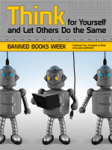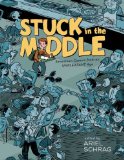For the first time since I’ve known of the map, you will find Sioux Falls on the map of book bans and challenges at the Banned Books Week website. The city’s appearance stems from a challenge to a book in the Sioux Falls School District last year, one begun, ironically, in the midst of last year’s Banned Books Week. Although I discussed the debate over the book at the time, this year’s Banned Books Week seems an appropriate time to review what happened.
 On Sept. 28, 2009, a parent of a sixth grade student at a Sioux Falls middle school filed a formal request that the School District remove a graphic novel, Stuck in the Middle: 17 Comics from an Unpleasant Age, from general access at the school’s library. The parent complained that the book, which contains material from 16 cartoonists based on their own middle school experiences, “contained repeated foul language, sexual references, and pictures of teenagers smoking.”
On Sept. 28, 2009, a parent of a sixth grade student at a Sioux Falls middle school filed a formal request that the School District remove a graphic novel, Stuck in the Middle: 17 Comics from an Unpleasant Age, from general access at the school’s library. The parent complained that the book, which contains material from 16 cartoonists based on their own middle school experiences, “contained repeated foul language, sexual references, and pictures of teenagers smoking.”
Following established policy and procedure, an “instructional review committee” evaluated the “values and faults” of the material, “viewing [it] as a whole and not individual passages or images.” The committee, composed of two parents, two teachers and an assistant principal, voted unanimously to place the book in the “professional section” of the two middle school libraries that had it. That meant “only teachers will be able to check it out.” The committee’s written report basically cited the “emotional maturity” of middle school students and a belief “the book would be more effective if a teacher chose specific selections and guided student discussion of those vignettes.”
 Although the School District procedure seems sound and it looks at a work as a whole and not just isolated parts of it, I am somewhat dismayed by the decision. (Full disclosure: Our law firm does legal work for the School District. I was not involved in and am not aware of anyone in the law firm who was consulted on this matter. My thoughts on the decision come as an avid reader and parent and are mine alone.) Granted, the challenge to the book was one in which the parent sought to limit access for all students, not just their child. Still, I think a less restrictive avenue was preferable. Rather than allowing only teachers to check out the book, why not also allow a parental opt-in? If a student provides verified written permission from their parent or guardian allowing him or her to check out the book, more protection is afforded the freedom to read. It also allows each family the opportunity to evaluate whether the book is appropriate given their son’s or daughter’s “emotional maturity” and, if they desire, to use the book as a learning tool.
Although the School District procedure seems sound and it looks at a work as a whole and not just isolated parts of it, I am somewhat dismayed by the decision. (Full disclosure: Our law firm does legal work for the School District. I was not involved in and am not aware of anyone in the law firm who was consulted on this matter. My thoughts on the decision come as an avid reader and parent and are mine alone.) Granted, the challenge to the book was one in which the parent sought to limit access for all students, not just their child. Still, I think a less restrictive avenue was preferable. Rather than allowing only teachers to check out the book, why not also allow a parental opt-in? If a student provides verified written permission from their parent or guardian allowing him or her to check out the book, more protection is afforded the freedom to read. It also allows each family the opportunity to evaluate whether the book is appropriate given their son’s or daughter’s “emotional maturity” and, if they desire, to use the book as a learning tool.
Granted, there were and are two copies of the book at the local library so it isn’t like students at the two middle schools had absolutely no access to the book. Still, when a book focuses on issues confronted by middle school students, isn’t a middle school library a highly appropriate place for it?
Parents and teachers have a responsibility to prepare the young to meet the diversity of experiences in life to which they will be exposed, as they have a responsibility to help them learn to think critically for themselves. These are affirmative responsibilities, not to be discharged simply by preventing them from reading works for which they are not yet prepared.
American Library Association, The Freedom to Read Statement








I think this is a really important issue to address, especially as I am a middle school teacher. I am philosophically against the banning of books, but in a very practical sense, some kids simply can’t handle some content even within its context. I wish more parents would be involved in not only what their children are reading, but also watching on television and in movies. Unfortunately, so many parents aren’t and it falls to the school to make critical decisions like the one you cite above. I tried to broach this topic on my blog, but it is still such a gray area in schools.
Thanks for the summary. I hadn’t heard about this case before. It’s very interesting.